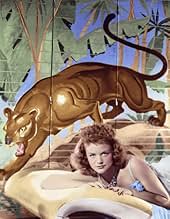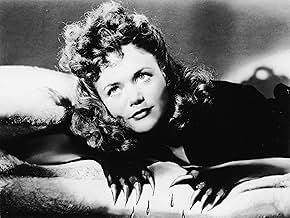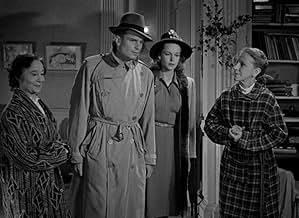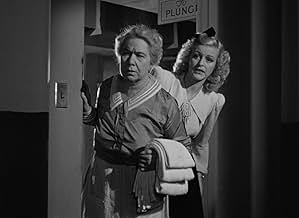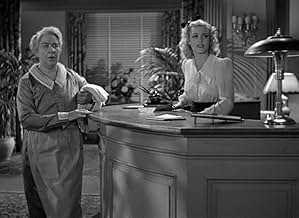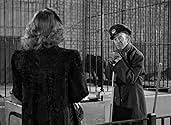IMDb-BEWERTUNG
7,2/10
27.657
IHRE BEWERTUNG
Ein Amerikaner heiratet eine serbische Einwanderin, die befürchtet, dass sie zur Katzenperson der Fabeln ihres Heimatlandes wird, wenn sie eng miteinander verbunden sind.Ein Amerikaner heiratet eine serbische Einwanderin, die befürchtet, dass sie zur Katzenperson der Fabeln ihres Heimatlandes wird, wenn sie eng miteinander verbunden sind.Ein Amerikaner heiratet eine serbische Einwanderin, die befürchtet, dass sie zur Katzenperson der Fabeln ihres Heimatlandes wird, wenn sie eng miteinander verbunden sind.
- Auszeichnungen
- 2 Gewinne & 3 Nominierungen insgesamt
Henrietta Burnside
- Sue Ellen
- (Nicht genannt)
Alec Craig
- Zookeeper
- (Nicht genannt)
Eddie Dew
- Street Policeman
- (Nicht genannt)
Elizabeth Dunne
- Mrs. Plunkett
- (Nicht genannt)
Dynamite
- The Panther
- (Nicht genannt)
Dot Farley
- Mrs. Agnew
- (Nicht genannt)
Mary Halsey
- Blondie
- (Nicht genannt)
Theresa Harris
- Minnie
- (Nicht genannt)
Charles Jordan
- Bus Driver
- (Nicht genannt)
Donald Kerr
- Taxi Driver
- (Nicht genannt)
Connie Leon
- Neighbor Who Called Police
- (Nicht genannt)
Murdock MacQuarrie
- Sheep Caretaker
- (Nicht genannt)
Alan Napier
- Doc Carver
- (Nicht genannt)
Empfohlene Bewertungen
Jacques Tourneur directed this Val Lewton production that stars Simone Simon as Irina Dubrovna, a Serbian immigrant working as a fashion artist in New York City who meets Oliver Reed(played by Kent Smith) at the zoo. They fall in love and get married, but run into trouble when she finds herself afraid of intimacy, since she believes the fables and legends of her homeland that indicate she is descended from a cursed line of Cat People, who turn murderous when aroused. He scoffs at this, but when his friend & co-worker Alice(played by Jane Randolph) is stalked by a cat-like creature, he begins to wonder. Meanwhile, Irina sees psychiatrist Dr. Louis Judd(played by Tom Conway) who has designs on Irina himself... Eerie and original film avoids monster movie clichés to create an effective atmosphere of dread. Quite intelligent as well, though requires patience, since it is decidedly different!
One doesn't want for a second to take credit away from screenwriter DeWitt Bodeen, one of the most intelligent scenarists the horror film evr had the benefit of. But it's a matter of record that producer Val Lewton, here as on all his horror pictures, was responsible for the initial premise and the screenplay's final draft. And one wonders how much of Lewton - one of those male writers who tended to form his most empathetic bond with his female characters - there is in Irene: like him an eastern european immigrant (she from Serbia, he from Russia, albeit second generation he grew up in an essentially Russian household) living in the very different world of 40's America, both hyper-sensitive (particularly over morbid fantasies regarding cats) and artists of an essentially solitary and modest nature, but prone to fits of violent temper. Certainly, Irene is one of the most vivid and haunting protagonists any horror film ever had. Some critics may disparage the film as inferior to its follow-up, 'I Walked With a Zombie', but although that's a more completely achieved work, none of its characters captures the imagination as Irene does. One scarcely needs to heap more praise on the most celebrated suspense sequences, but the rest of the movie is more than just a set-up for these. It is, for one thing, oneof the supreme evocations of spiritual loneliness in the cinema. As Irene huddles by the doorknob between her and husband Oliver, while the panther in the nearby zoo calls out through the wintery night, this is an evocation of an isolation more than merely physical and tragically irrevocable. Lewton also had on his side, in this instance, the best of his directors, Jacques Tourneur, a sensualist (which could scarecely be said of his successors, Mark Robson and Robert Wise) who makes of the story a sort of tactile poem in the textures of the black fur of Irene's coat, the silk of her stockings, the flakes of falling snow on Irene and Oliver's wedding night, the wet tarmac across which Jane Randolph has to make her scary walk home, the ebony of an Egyptian cat-statue, the fabric of a couch torn by Irene's fingernails, the white enamel of Irene's bath-tub and the gleaming dusky hunch of her wet shoulders as she sits weeping within. This is a subtle movie, but also an intensely physical one. If there is a weak spot, it lies with the casting of Kent Smith as 'good plain Americano' Oliver Reed. His boy next door charm is hopelessly inadequate to the context of Irene's drama and he increasingly seems doltish and blindly insensitive in the blandness of his responses to her torment. The film might have been greater still if Lewton had cast an edgier, fierier actor, one whose incomprehension of Irene might have betrayed its own violent streak and extended the 'cat people' metaphor beyond Irene herself. Think of someone like John Garfield in the role! But Garfield would have been out of Lewton's budget range and one can scarcely harangue the producer for being too modest, in the production of his first quickie horror, for fully grasping how rich a work of film poetry he and his collaborators were in the process of creating. But poetry it is. The horror genre has never produced as much of that as it ought to have done, so for heaven's sake, make the most of this and the other Lewton productions.
After several movies made in his native France ,Jacques (Jack) Tourneur makes his first American works in the late thirties."Cat people" is the fifth one;the others are difficult to see and anyway this is this movie that is looked upon as his towering achievement(with the exception of "out of the past") .His female star,Simone Simon,whose English was perfect,enjoyed a career in both countries too:her best part is easily Jean Renoir's "la bête humaine" ,(human beast:it's funny when you know she's playing a woman-animal here).
"Cat people" belongs to the fantasy and horror genre,but it does not really follow its rules.We're close to psychological drama.(Almost) deprived of "special effects" -which is a blessing-Tourneur works with his camera the way a painter does with shadow and light to create strange dreamy atmospheres The pièces de résistance are the scene in the swimming -pool that creates a feeling of terror without using the tricks of the trade,and the scene when Oliver and Alice are in the flat,hearing roaring.
The movie was ahead of its time in several respects:the Freudian allusions would later be developed by Fritz Lang("secret beyond the door",1945) and of course Hitchcock ("Spellbound",same year).You're going to say that these two great directors give their movies a "realistic" treatment and Jack Tourneur does not.Actually,he takes a divergent way:he introduces ambiguity,this ambiguity dear to Roman Polanski .After all,it could be a mere ,so to speak, neurosis.Few of the sequences actually deal with the supernatural :most of the time,it's a couple then a triangle:the "fantastic" elements could be real :the disturbing woman,who calls Irene "my sister",the scenes with the panther at the zoo,and the pool sequence can be explained by Irène's jealousy.
Although,it's only understood ,it's obvious that the marriage Irène/Oliver has not been consummated,because of a not clearly defined reason-how can a man as pragmatist as Oliver believe in such a far-fetched curse?Isn't it the fear of woman,of the original sin?.This topic will be brilliantly taken on by Christian de Challonges "l'alliance" (1970).Note also how Richard Donner aped the pet shops scene for "the omen" (1976).
It seems that Alice's character is an easy way out,and the weak part of the movie because she's essentially here to comfort the audience,to show the way to "straight" life and to secure a happy end.
The remake (1982) destroys all ambiguity,keeps nothing from the original story but the proper nouns ,and fills its quota of nudity and blood.Stick to the Tourneur version.
"Cat people" belongs to the fantasy and horror genre,but it does not really follow its rules.We're close to psychological drama.(Almost) deprived of "special effects" -which is a blessing-Tourneur works with his camera the way a painter does with shadow and light to create strange dreamy atmospheres The pièces de résistance are the scene in the swimming -pool that creates a feeling of terror without using the tricks of the trade,and the scene when Oliver and Alice are in the flat,hearing roaring.
The movie was ahead of its time in several respects:the Freudian allusions would later be developed by Fritz Lang("secret beyond the door",1945) and of course Hitchcock ("Spellbound",same year).You're going to say that these two great directors give their movies a "realistic" treatment and Jack Tourneur does not.Actually,he takes a divergent way:he introduces ambiguity,this ambiguity dear to Roman Polanski .After all,it could be a mere ,so to speak, neurosis.Few of the sequences actually deal with the supernatural :most of the time,it's a couple then a triangle:the "fantastic" elements could be real :the disturbing woman,who calls Irene "my sister",the scenes with the panther at the zoo,and the pool sequence can be explained by Irène's jealousy.
Although,it's only understood ,it's obvious that the marriage Irène/Oliver has not been consummated,because of a not clearly defined reason-how can a man as pragmatist as Oliver believe in such a far-fetched curse?Isn't it the fear of woman,of the original sin?.This topic will be brilliantly taken on by Christian de Challonges "l'alliance" (1970).Note also how Richard Donner aped the pet shops scene for "the omen" (1976).
It seems that Alice's character is an easy way out,and the weak part of the movie because she's essentially here to comfort the audience,to show the way to "straight" life and to secure a happy end.
The remake (1982) destroys all ambiguity,keeps nothing from the original story but the proper nouns ,and fills its quota of nudity and blood.Stick to the Tourneur version.
At the zoo, Oliver Reed (Kent Smith) sees the mysterious Irena Dubrovna (Simone Simon), who is sketching a black panther. He's intrigued by her--it seems to be love at first sight--and is surprised when she invites him into her apartment for a cup of tea. While in her apartment, he sees an odd statue of a man on horseback, holding a sword-skewered cat high in the air. Dubrovna tells him of her native Serbia, and the legend of unchristian "cat people" who were driven into the mountains. Dubrovna's behavior becomes increasingly odd, and animals often react strangely to her. Could she have something to do with the legend of the cat people?
This was director Jacques Tourneur and producer Val Lewton's first horror/thriller film together (they were to do two others together, I Walked With A Zombie (1943) and The Leopard Man (1943)), and for my money, this is the best of the three. Lewton was famous for understated, atmospheric horror that suggested more than it showed, a style that is also evident in his later collaborations with director Robert Wise (who went on to direct the infamous The Haunting (1963), which is often thought to be a pinnacle of this more "suggestive" style, although it's not a particular favorite of mine).
So what does this mean? Well, a lot of younger horror fans, for whom the oldest film that they are really familiar with in the genre is something like The Texas Chainsaw Massacre (1974) or an even more recent film, might be reluctant to call Cat People a horror film. It is "talky", doesn't contain any graphic violence, and we don't even see a horror creature/villain until just a glimpse near the very end of the film. But it is horror--the talking is centered on a captivating supernatural "myth", there are a lot of creepy, well-photographed scenes laden with heavy shadows, there are a couple exquisite chase/suspense scenes, and there is a lot of complex, dark psychological interaction.
The psychological tension is really the focus, as Lewton and Tourneur's films together are moral parables that function more as a metaphor for horror (rather than the more common flipside, where the horror is more prominent and might be a metaphor for some other kind of philosophical point). In this case, the moral and social situations are varied and complex, but are all focused on romantic relationships, ranging from quick actions taken due to lust, to emotional distancing, adultery and abuse of power. The more one watches the film, the more one is likely to get out of the subtextual messages. They remain more subtextual than they might in modern cinema because of content restrictions imposed by studios in this era (although of course those were a reaction to prevalent cultural attitudes at the time). But in retrospect, the buried nature of the themes is a benefit, at least in this case.
Occasionally, the horrific aspect of these types of films can be too understated, so that they simply become realist dramas. That's not the case here. This is a film that is rewarding on many levels.
A 9 out of 10 from me.
This was director Jacques Tourneur and producer Val Lewton's first horror/thriller film together (they were to do two others together, I Walked With A Zombie (1943) and The Leopard Man (1943)), and for my money, this is the best of the three. Lewton was famous for understated, atmospheric horror that suggested more than it showed, a style that is also evident in his later collaborations with director Robert Wise (who went on to direct the infamous The Haunting (1963), which is often thought to be a pinnacle of this more "suggestive" style, although it's not a particular favorite of mine).
So what does this mean? Well, a lot of younger horror fans, for whom the oldest film that they are really familiar with in the genre is something like The Texas Chainsaw Massacre (1974) or an even more recent film, might be reluctant to call Cat People a horror film. It is "talky", doesn't contain any graphic violence, and we don't even see a horror creature/villain until just a glimpse near the very end of the film. But it is horror--the talking is centered on a captivating supernatural "myth", there are a lot of creepy, well-photographed scenes laden with heavy shadows, there are a couple exquisite chase/suspense scenes, and there is a lot of complex, dark psychological interaction.
The psychological tension is really the focus, as Lewton and Tourneur's films together are moral parables that function more as a metaphor for horror (rather than the more common flipside, where the horror is more prominent and might be a metaphor for some other kind of philosophical point). In this case, the moral and social situations are varied and complex, but are all focused on romantic relationships, ranging from quick actions taken due to lust, to emotional distancing, adultery and abuse of power. The more one watches the film, the more one is likely to get out of the subtextual messages. They remain more subtextual than they might in modern cinema because of content restrictions imposed by studios in this era (although of course those were a reaction to prevalent cultural attitudes at the time). But in retrospect, the buried nature of the themes is a benefit, at least in this case.
Occasionally, the horrific aspect of these types of films can be too understated, so that they simply become realist dramas. That's not the case here. This is a film that is rewarding on many levels.
A 9 out of 10 from me.
I have this theory about the horror films of Val Lewton. It is my contention that these movies caused a sea change in the content and tone of the movies of Alfred Hitchcock. The reason I say this is simple, really: Lewton is the only filmmaker I have ever caught Hitchcock cribbing scenes from. He did it twice. Once from The Seventh Victim (dir. by Mark Robson), which I swear to god provides the first half of the Shower Scene from Psycho. The second from Cat People, which provided the pet store scene in The Birds. This second scene is almost a shot for shot swipe. Both of these steals are evidence that Hitch knew and admired the Lewton movies. More than that, though, there is a change in the subtext of Hitchcock's thrillers after the Lewton movies. The movies he made before them were cut from the Fritz Lang mold of political thrillers. After the Lewton movies, Hitch's movies became more psychosexual in nature. Vertigo, for instance, could easily fit into Lewton's output.
Cat People is the first of the Lewton movies and sets the tone for them. It pretends to be about a McGuffin (serbian were -panthers), but is actually about something else (in this case, frigidity and repressed lesbianism). This represents a huge change in the evolution of the horror movie. Cat People is the first horror movie to explore these themes as central concerns rather than as sub-rosa undercurrents. It also pioneered the techniques of film noir (which as a genre didn't really exist yet). Cat People is strikingly stylized and its effect is of stranding the viewer in the middle of a darkened room with some dreadful beast circling just outside his sphere of perception. This has a hell of an impact--particularly if you have the good fortune to see this in a theater. I'm not going to claim that Cat People is one of the best horror movies ever made (it does have flaws), but it is one of the four most influential horror movies ever made (along with The Cabinet of Dr. Caligari, Psycho, and Night of the Living Dead). But unlike its brethren, its influence spreads corrosively through the entirety of cinema through both film noir and the films of Alfred Hitchcock. You would be hard pressed to find any film short of Citizen Kane or Rashomon that is nearly as influential.
Cat People is the first of the Lewton movies and sets the tone for them. It pretends to be about a McGuffin (serbian were -panthers), but is actually about something else (in this case, frigidity and repressed lesbianism). This represents a huge change in the evolution of the horror movie. Cat People is the first horror movie to explore these themes as central concerns rather than as sub-rosa undercurrents. It also pioneered the techniques of film noir (which as a genre didn't really exist yet). Cat People is strikingly stylized and its effect is of stranding the viewer in the middle of a darkened room with some dreadful beast circling just outside his sphere of perception. This has a hell of an impact--particularly if you have the good fortune to see this in a theater. I'm not going to claim that Cat People is one of the best horror movies ever made (it does have flaws), but it is one of the four most influential horror movies ever made (along with The Cabinet of Dr. Caligari, Psycho, and Night of the Living Dead). But unlike its brethren, its influence spreads corrosively through the entirety of cinema through both film noir and the films of Alfred Hitchcock. You would be hard pressed to find any film short of Citizen Kane or Rashomon that is nearly as influential.
Wusstest du schon
- WissenswertesThe horror movie technique of slowly building tension to a jarring shock which turns out to be something completely harmless and benign became known as a "Lewton bus" after a famous scene in this movie created by producer Val Lewton. The technique is also referred to as a "cat scare," as off-screen noises are often revealed to be a startled harmless cat.
- PatzerWhen Irena does not show up at her apartment when Dr. Judd, Oliver, and Alice are waiting for her, they leave. Dr. Judd hides his cane in the apartment to give him an excuse to borrow Oliver's key and go back in for it. Afterward, he leaves the door unlocked so that he can sneak back in, something that is hidden from Oliver and Alice. Yet, after Oliver and Alice are threatened in the office, they call the apartment to warn Dr. Judd that Irena is definitely dangerous and that he should leave.
- Zitate
Irena Dubrovna: I like the dark. It's friendly.
- Crazy Credits[From the opening credits] "Even as fog continues to lie in the valleys, so does ancient sin cling to the low places, the depression sin the world consciousness." - "The Anatomy of Atavism" - Dr. Louis Judd
- VerbindungenFeatured in Draculeena Presents: Cat People (1960)
Top-Auswahl
Melde dich zum Bewerten an und greife auf die Watchlist für personalisierte Empfehlungen zu.
Details
- Erscheinungsdatum
- Herkunftsland
- Sprachen
- Auch bekannt als
- La marca de la pantera
- Drehorte
- Produktionsfirma
- Weitere beteiligte Unternehmen bei IMDbPro anzeigen
Box Office
- Budget
- 134.000 $ (geschätzt)
- Laufzeit
- 1 Std. 13 Min.(73 min)
- Farbe
- Seitenverhältnis
- 1.37 : 1
Zu dieser Seite beitragen
Bearbeitung vorschlagen oder fehlenden Inhalt hinzufügen



